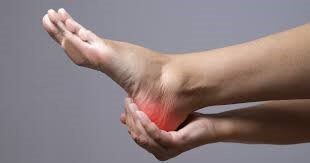A heel spur or calcaneal spur is a small, scrawny outgrowth of the bone, which can be spotted by an X-ray of the foot. It is a calcium deposit that occurs when the bones in the foot are exposed to continuous stress, such as flat feet, high heels, or obesity. There is a bony protrusion on the base of the heel bone, the shape looks like a hook with a spikey edge. When you see the X-ray, a heel spur spreads forward by around half an inch. If there is no visible X-ray indication, the condition is also known as “heel spur disorder”.
Heel spurs are generally triggered by tenderness and soreness, can be caused by worsening arthritis (osteoarthritis) or tendonitis. It doesn’t cause any distress or unease until it is big in size, which can lead to aberration. Heel spurs occur in surrounding areas of swelling or damage of adjacent cartilage or ligaments. Although, they are often painless, but can cause pain in the heel, particularly in the morning or when you do regular walking or run in the park or the treadmill. It even gets numb and weak, if they are affecting the nearby tissues. They are generally related to plantar fasciitis, painful swelling, and soreness of the fibrous band of the plantar fascia (a connective tissue), that moves along the bottom of the foot and attaches the heel bone of the ball of the foot.
What causes Heel Spur?
Heel spurs happen when calcium deposits accumulate beneath the heel bone. It is a process that generally takes place over several months. Heel spurs are usually caused by strains or pressure on the foot muscles and ligaments, stretching of the plantar fascia, and frequent ripping of the membrane that shields the heel bone. Heel spurs are particularly common amongst sportspersons whose activities consist of running and jumping. Risk factors for heel spurs comprise of:
- Overuse of foot in activities like jumping, running, or jogging particularly on the hard surfaces
- Incorrect footwear either bad-fitting or non-supportive footwear can cause bone spurs
- Overweight, the more the weight, the more chances of getting heel spur
- Walking style anomalies, which puts extreme pressure on the heel bone, tendons, and nerves near the heel
What is the treatment for Heel Spur?
Cure for heel spurs and related conditions involve exercise, specially-made orthotics, anti-inflammatory medicines and cortisone injections. If conventional treatments fail, surgery may be needed. Apart from that,
- Rest
- Icing
- Stretching exercises
- Foot orthotics are shoe inserts
- Physiotherapy
When to visit a Doctor?
Although, heel spurs have no signs or symptoms, they can be associated with chronic and intermittent pain. If you are also facing pain in your heel over a period of time and unable to do regular activities, you should refer to an orthopedic expert doctor before it gets worse. Consult our team of experts at the Bansal Global Hospital immediately.
Fix your appointment today and contact us at +919911062832


 MAKE AN APPOINTMENT
MAKE AN APPOINTMENT